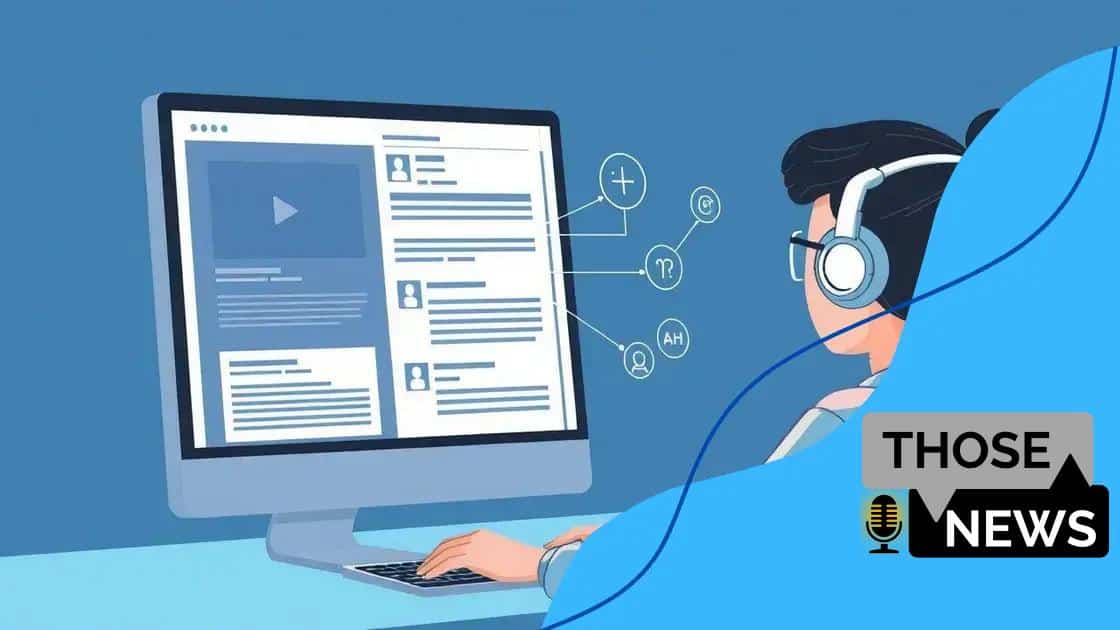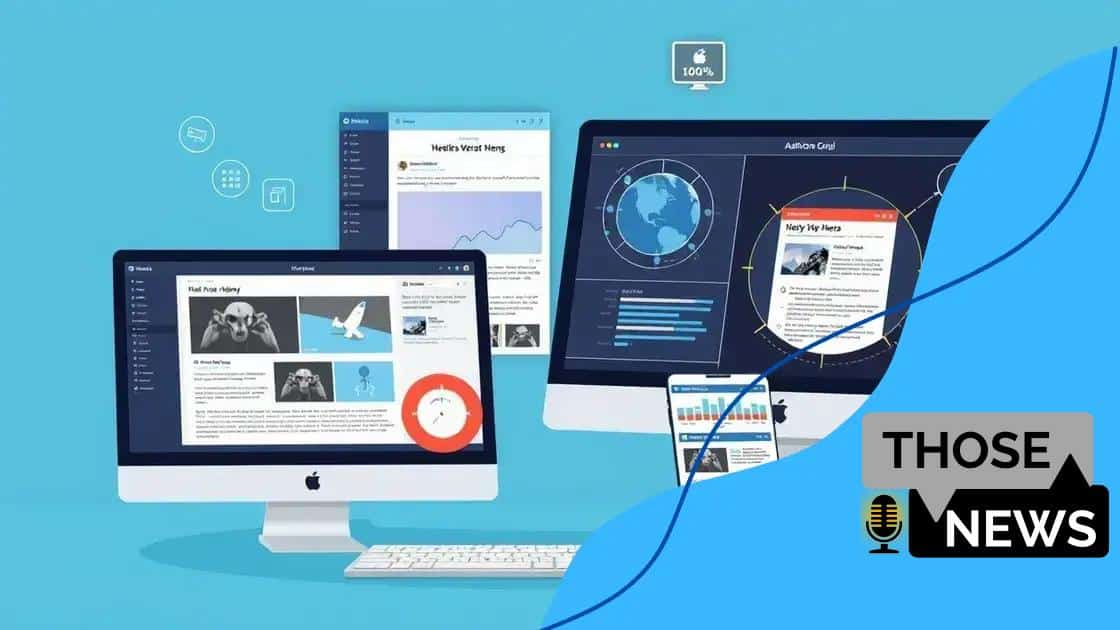AI tools for detecting misinformation: your guide

AI tools for detecting misinformation enhance accuracy in identifying false information by leveraging advanced algorithms, natural language processing, and continuous learning to empower users in navigating the complex online information landscape.
AI tools for detecting misinformation are becoming essential in today’s digital world. With the rise of fake news, knowing how to utilize these tools can significantly enhance your ability to discern truth from fabrication.
Understanding misinformation and its impact
Misinformation is a growing concern in our digital age. Understanding misinformation and its impact on society is crucial for everyone. This phenomenon can spread quickly, creating confusion and mistrust. It’s vital to distinguish between fact and fiction.
What is Misinformation?
Misinformation refers to false or misleading information that is spread, regardless of intent. It can appear in various forms, from social media posts to news articles. Recognizing misinformation requires critical thinking.
Why It Matters
The impact of misinformation is significant. It can influence public opinion, affect decision-making, and even interfere with democratic processes. When people rely on inaccurate information, it can lead to panic or harm.
- Causes confusion among the public.
- Undermines trust in legitimate sources.
- Can incite panic during crises.
- Misleads individuals on important issues, like health.
In addition to these consequences, misinformation can lead to real-world effects. For instance, incorrect health advice can endanger lives. People may make choices based on false narratives, believing they are acting in their best interest. This highlights the need for awareness and vigilance against misinformation.
Combatting misinformation starts with education. Understanding how to identify credible sources is essential. Engaging with content critically will help individuals sift through the noise and find the truth. It’s not just about finding information; it’s about understanding the source and intent behind it.
By fostering a culture of skepticism and inquiry, we can mitigate the damage caused by misinformation. Individuals must ask questions and verify information before sharing it with others.
How AI tools can help identify false information
AI tools are reshaping the way we approach the challenge of identifying false information. These advanced technologies can analyze vast amounts of data quickly, helping users pinpoint what is real and what is not. By leveraging machine learning algorithms, AI tools can detect patterns in information that humans might miss.
How Does AI Work?
AI tools utilize techniques such as natural language processing (NLP) to understand the context of information. This involves analyzing text for contradictions, identifying reliable sources, and checking the accuracy of facts. The ability of AI to process and evaluate content at a speed unmatched by humans is a game-changer.
Benefits of Using AI Tools
Integrating AI tools into the detection of misinformation brings many advantages:
- Increased speed in identifying false claims.
- Ability to analyze diverse sources.
- Reduction of human bias in evaluation.
- Continuous learning to adapt to new misinformation tactics.
These tools not only assist individual users but also empower organizations to manage information more efficiently. For example, journalists can use AI to fact-check statements before publication. Fact-checking organizations benefit from AI systems that can rapidly evaluate the credibility of news items.
Furthermore, AI tools can aid in educating the public about misinformation. By providing users with alerts or explanations about suspicious claims, these tools promote awareness and critical thinking. This way, the public is better equipped to recognize misleading information and make informed decisions.
As technology evolves, so do the methods used by those spreading misinformation. AI tools must also evolve, continually being refined to stay ahead of new tactics. Investing in these technologies is essential for creating a safer information environment.
Top AI tools available for detecting misinformation

When it comes to fighting misinformation, several AI tools stand out. These tools help users differentiate between credible information and misleading content. They offer a range of features designed to analyze and verify news effectively.
Leading AI Tools
Among the best options available today are:
- Poynter’s PolitiFact: Known for its accuracy, this tool checks statements made by politicians and public figures.
- FactCheck.org: A reliable platform that evaluates claims and provides sources to back its findings.
- Snopes: This well-established site investigates rumors and urban legends, helping clear misconceptions.
- Google Fact Check Tools: A resource that allows users to find fact-checked information quickly using a simple search.
These tools utilize advanced algorithms to cross-reference data and identify inconsistencies. However, their effectiveness depends on user engagement. To truly benefit from these resources, individuals need to incorporate them into their daily routines when consuming news.
Understanding how to utilize these AI tools can empower users. They should check claims before sharing them online. This practice not only enhances personal knowledge but also reduces the spread of misinformation. With easy access to reliable resources, anyone can be better informed.
As technology advances, new tools will continue to emerge, offering even more robust features for spotting false information. Staying updated with the latest developments in AI tools can help individuals navigate an increasingly complex information landscape.
Best practices for using AI in misinformation detection
Using AI in misinformation detection can greatly enhance our ability to identify false information. Implementing best practices is essential to ensure these tools are effective. Proper use not only improves accuracy but also builds trust in the results.
Stay Informed
One of the best practices is staying informed about how AI tools work. Understanding their capabilities and limitations helps users make better decisions. By knowing when to trust the outputs, users can effectively integrate AI into their information verification processes.
Verify Multiple Sources
Another crucial practice is to verify information against multiple sources. Relying solely on one AI tool can lead to gaps in knowledge or errors. Cross-referencing information helps confirm its accuracy.
- Utilize established fact-checking websites.
- Consult diverse news sources for a broader perspective.
- Look for expert opinions to validate claims.
In addition, it is important to keep technology updated. Regular updates to AI tools can enhance their effectiveness in detecting new forms of misinformation. Staying current with the latest advancements allows users to take advantage of improved features and ongoing developments in AI.
Lastly, engage actively with the tools. This involves analyzing the results critically. Understanding why an AI tool flagged certain content can provide insight into its decision-making process. This engagement leads to better outcomes in identifying misinformation.
By applying these best practices, individuals can maximize the benefits of AI in combating misinformation. It creates a proactive approach towards information consumption and sharing, ultimately fostering a more informed public.
Future trends in AI and misinformation detection
The landscape of misinformation detection is rapidly evolving, driven by advancements in AI technology. Understanding future trends is crucial for staying ahead in combating false information. As AI tools become more sophisticated, they will provide more accurate and efficient solutions for identifying misleading content.
Enhanced Natural Language Processing
One major trend is the improvement of natural language processing (NLP). Future AI systems will better understand context, nuance, and sentiment, making them more effective in detecting subtle forms of misinformation. This enhanced capability will allow tools to evaluate not just the content but the surrounding context.
Integration of Machine Learning
Another trend is the increased integration of machine learning. AI tools will learn from user interactions and continuously refine their algorithms. For example, as users provide feedback on flagged content, the AI can adapt its learning to become more precise in future detections.
- Adaptive algorithms that evolve with new misinformation tactics.
- Real-time updates based on current events.
- Enhanced user feedback loops for continuous improvement.
Moreover, there will be greater collaboration between tech companies and researchers. This partnership will ensure that AI tools are designed with ethical considerations in mind. It will be essential to prioritize preventing bias in AI systems. This helps guarantee fair and accurate detection of misinformation across diverse populations.
As awareness of misinformation grows, so does the demand for effective tools. Users will likely see more accessible AI solutions integrated into social media platforms and news applications. These features can alert users to potential false claims instantly, empowering individuals to verify information before sharing it.
The future of misinformation detection is bright, with AI leading the charge. By understanding these trends, individuals and organizations can prepare to adopt innovative tools that help maintain the integrity of information in our digital lives.
FAQ – Questions about AI tools for detecting misinformation
What are AI tools for misinformation detection?
AI tools are advanced technologies that analyze information, identifying and flagging false claims to help users discern truth from misinformation.
How can I use AI tools effectively?
To use AI tools effectively, stay informed about their capabilities, verify information against multiple sources, and engage critically with the results they provide.
Are there specific AI tools I should consider?
Yes, popular tools like Poynter’s PolitiFact, FactCheck.org, and Snopes are highly effective for checking false information and verifying claims.
What role does machine learning play in misinformation detection?
Machine learning helps AI tools learn from user interactions, improving their accuracy over time by adapting to new misinformation tactics and trends.





